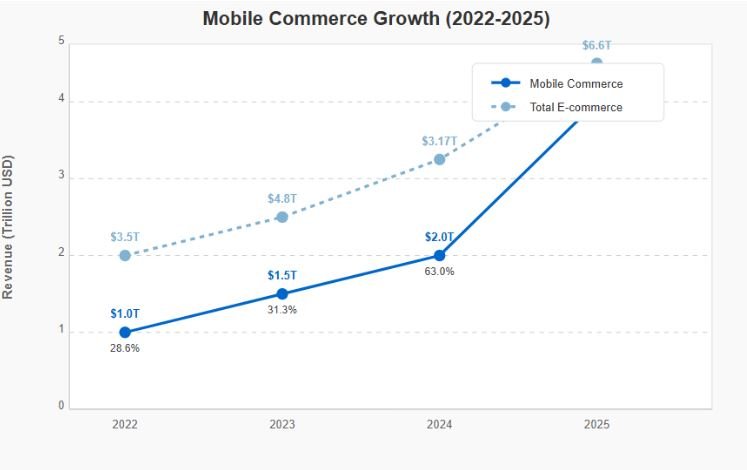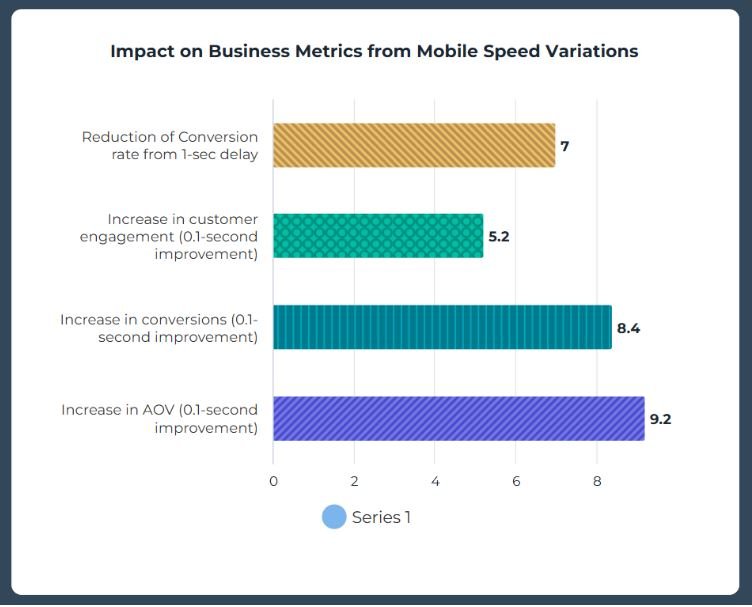AI-Powered Martech: Unlocking Hyper-Personalization and Real-Time Campaign Success


The growth of mobile commerce has been nothing short of transformative. In e-commerce businesses, speed is everything. Faster load speeds and smooth user experiences can make or break a business; nowhere is this truer than in mobile commerce (m-commerce). As more and more smartphones are adopted, the number of consumers shopping through these devices also increases.
According to Statista, mobile commerce is expected to reach a revenue of $2 trillion by 2024, nearly doubling over the subsequent 4 years and encompassing 63 percent of total retail e-commerce. By 2025, the e-commerce industry is projected to hit $6.6 trillion. This rapid growth means that by 2025, 75% of total e-commerce transactions will occur via mobile devices.

Mobile commerce (m-commerce) includes transactions done via mobile devices such as smartphones or tablets. Rather than just “e-commerce on smaller screens,” m-commerce illustrates a drastic change in buying behavior with different interactions, contexts, and technical details.
When distinguishing m-commerce from traditional e-commerce, it is important to note that m-commerce lacks engagement. Mobile shoppers are less tolerant of prolonged purchasing processes, which include any perceived friction, like time-consuming delays. This allows them to make more impulse purchases in shorter but recurrent shopping sessions.
M-commerce allows consumers to purchase various items online, such as books, tickets, and digital music, and perform banking transactions via mobile devices, as long as there is wireless internet connectivity.
Mobile speed is a critical issue, and not only from a technical point of view; it’s a business issue in the first place. Customers disengage from slow mobile experiences, while seamless and effortless mobile transactions lead to greater customer engagement and, subsequently, sales.
According to Google’s latest research, 53% of mobile visitors abandon sites that take more than 3 seconds to load, yet the average mobile page still takes approximately 15.3 seconds to fully load on 4G connections.
A 1-second delay in page load time can reduce conversion rates by 7%. For a business generating $100,000 per day, that single-second delay could mean losing $2.5 million annually in potential revenue. In a recent study by Deloitte across a range of retail sectors, it was found that improving mobile speed by just 0.1 seconds led to:

Customer satisfaction is enhanced using fast mobile experiences, leading to repeat customers. According to Akamai, 79% of customers dissatisfied with site performance are less likely to purchase from the same site in the future.
Google uses mobile-first indexing to give priority to mobile pages that load quickly. In addition to receiving less traffic, poorly performing websites also appear lower in search engine results pages (SERPs), which reduces their organic reach and opportunity for acquiring new customers.
The rapid growth in mobile shopping makes it highly likely that many established e-commerce operators are unhappy with any technological decisions made in the past. Almost all legacy systems are subject to monolithic architectures and traditional relational databases that constantly fall behind concerning modern performance expectations.
The complete replacement of legacy systems is not always achievable, but strategic modernization focusing on performance bottlenecks can deliver significant gains.
The strategy to modernize and boost mobile site speed has to be incremental and requires a multifaceted approach encompassing technical, design, and operational enhancements.
1. Implement Accelerated Mobile Pages (AMP) AMP is an open framework that allows lightweight pages to be created with great ease. Companies using AMP report significant improvements in speed and user interaction involving a site’s engagement metrics.
2. Prioritize Mobile-first Design
The website developers must optimize the websites for small screens, with all the required design and features suitable for touchscreen devices, such as swipe gestures, zoom-in/out options, etc., to view the product in detail.
3. Optimization of Images
Images generally account for the largest single portion of the page weight, typically closer to 60%. These assets can be optimized and compressed to achieve faster load times without reducing quality and compromising user experience.
4. Leverage Content Delivery Networks (CDNs)
A CDN stores copies of your site on servers worldwide, ensuring faster delivery by reducing the distance between the user and your content.
5. Adopt Progressive Web Apps (PWAs)
PWAs offer faster load times and offline functionality by combining the greatest aspects of online and mobile applications.
6. Optimize Mobile Checkout
A quick and easy checkout reduces basket abandonment. Friction is decreased by using strategies like auto-fill forms and one-click checkout.
The application of Hyperautomation with Artificial Intelligence (AI) significantly improves the efficiency of m-commerce services. AI speeds up decision-making and increases productivity in a variety of applications, including personalized shopping experiences and predictive analytics.
By predicting user behavior and adapting experiences in real time, AI-driven systems are creating unprecedented performance improvements:
At RBM Software, we integrate AI-driven solutions to optimize search functionality, streamline product recommendations, and automate QA processes. Thorough QA testing is performed to ensure your next mobile commerce product is launched smoothly and bug-free.
Replacing monolithic applications with decentralized mobile services has led to the expansion of microservices architecture and raised the bar for mobile commerce systems.
Key benefits of mobile performance include:
Microservices are not only an architectural pattern but they also serve as a business strategy that improves resilience and performance and consequently increases profit margins. For mobile commerce specifically, they allow precise optimization of the pathways most critical to conversion.
M-commerce enables seamless omnichannel experiences by integrating online and offline touchpoints. Customers can easily initiate their shopping across any platform and complete it on the platform of their choosing without dividing their experience. According to the Harvard Business Review, 73% of consumers use various channels for shopping. Offering a strong omnichannel experience increases customer lifetime value by 30%.
The performance of mobile-friendly websites affects conversion rates. As SaleCycle reports, over half of e-commerce sales in 2023 came from mobile devices. Conversion rates can easily be increased through the use of one-click checkout features and mobile wallets like Apple Pay, Google Pay, Amazon Pay, etc.
M-commerce creates stronger customer relationships through personalized experiences and loyalty programs. A survey states that 83% of consumers say loyalty programs influence their decision to buy again.
Websites optimized for mobile run faster, improve brand visibility, and rank higher in search engine results. A study of Hubspot found that 63% of customers prefer to search for brand and product information using mobile devices. This, along with Google’s Core Web Vitals mobile performance metrics, explains why SEO rankings are affected.
M-commerce platforms provide organizations wishing to grow with affordable scalability. Microservices design and cloud-based solutions enable businesses to manage traffic surges without experiencing performance deterioration. According to Gartner and McKinsey, companies that implement cloud-native solutions can see up to a 40% decrease in operational costs.
Mobile commerce is no longer a future but a present, and it continues evolving rapidly, with several emerging trends creating new performance challenges and opportunities:
Users expecting the ability to see products in AR mode is increasingly common. Companies like IKEA and Lenskart are utilizing virtual AR features like “Try On” to help consumers try the product before they buy. As these features are becoming mainstream, they create unprecedented performance demands:
Several e-commerce businesses are increasingly utilizing voice-based features to allow consumers to shop for products without even typing in a product name. Shopping through speaker-enabled devices or a phone’s virtual assistant comes with its own set of problems to solve:
User experience expectations increase when working with any advanced technology, but with 5G, the user must also expect the complete opposite concerning the planned speed:
PWAs bridging the gap between web and native applications are becoming the standard for mobile commerce:
As mobile commerce develops further, businesses that are ready for these new trends now will continue to have a competitive edge.
Speed isn’t simply among the technical considerations in mobile commerce. Across the world, it has become a primary business differentiator with significant revenue implications and one that, when treated accordingly, creates measurable advantages in both conversion and retention, along with grabbing market share.
Boost your mobile commerce performance with RBM Software!
We specialize in modernizing traditional legacy systems using cutting-edge AI technologies—scalable, fast, and cost-effective. Connect with us today to partner with our offshore team and unlock the next level of e-commerce success. Let’s build the future together!